|
1. An immersed phase field model for fracture-induced Darcy-Stokes flow (presented by PhD student Hyoung Suk Suh). Invited paper published in Physics of Fluid [URL] 2. An accelerated model-free poroelasticity solver with multifidelity multiphysics data (presented by PhD student Bahador Bahmani). Paper accepted by CMAME [URL] 3. AI-generated interpretable plasticity theory (presented by PhD student Nick Vlassis). Paper accepted by CMAME [URL] 4. Crystal plasticity with precipitation creeping, crack growth and healing in rock salt (presented by associate research scientist Dr. Ran Ma). Paper accepted in CMAME [URL] 5. Domain Partitioning MPM for thermomechanical contact mechanics with fragmentation (presented by PhD student Mian Xiao). Paper under review. 6. ILS-MPM: an implicit level-set-based material point method for contact mechanics (presented by former postdoctoral research scientist, now associate professor of Chinese Academy of Sciences, Prof. Chuanqi Liu). Paper accepted in CMAME [URL] 7. Digital rock physics via FFT Solver (presented by PhD student Zeyu Xiong). 8. Numerical Investigation on freezing and thawing of saturated soil (presented by postdoc research scientist Dr. Qing Yin).
0 Comments
2019-07-29
#1971999 - A Cooperative Two-player Game for Data-driven Discovery of Elasto-plasticity Knowledge Represented in Directed Graph 02:00 - 02:20 Minisymposium#203 Data-driven Modeling Using Uncertainty Quantification, Machine Learning and Optimization Authors Kun Wang ,WaiChing Sun * ,Qiang Du LocationR oom # Lone Star Ballroom F - LVL 3 We introduce a multi-agent meta-modeling game to generate data, knowledge, and models that make predictions on constitutive responses of elasto-plastic materials. We introduce a new concept from graph theory where a modeler agent is tasked with evaluating all the modeling options recast as a directed multigraph and find the optimal path that links the source of the directed graph (e.g. strain history) to the target (e.g. stress) measured by an objective function. Meanwhile, the data agent, which is tasked with generating data from real or virtual experiments (e.g. molecular dynamics, discrete element simulations), interacts with the modeling agent sequentially and uses reinforcement learning to design new experiments to optimize the prediction capacity. Consequently, this treatment enables us to emulate an idealized scientific collaboration as selections of the optimal choices in a decision tree search done automatically via deep reinforcement learning. 2019-07-31 #1971644 - Data-driven Validation of Bishop’s Effective Stress Principle through Deep Reinforcement Learning 02:20 - 02:40 Minisymposium#105 Computational Geomechanics, in honor of Prof. Mary F. Wheeler Authors Yousef Heider * ,Kun Wang ,Hyoung Suk Suh ,WaiChing Sun Location Room # Lone Star Ballroom C - LVL 3 In analogy to Terzaghi’s effective stress principle in fully-saturated porous media, Bishop’s effective stress principle presents a partition of the total stress in unsaturated porous media between suction and effective stress contributions. Although widely applied in Geomechanics, the validity and generality of Bishop’s principle across saturation regimes still a matter of debate, especially for path-dependent materials that exhibit hysteresis retention behaviors. The proposed meta-modeling automated learning approach makes use of data-based constitutive modeling, generated via reinforcement learning, to evaluate the validity and generality of Bishop’s effective stress principle for various types of blind predictions involving material failures, such as strain localization and brittle fracture. Synthetic micro-structural-based data of unsaturated granular materials (such as coordination number, fabric tensor, porosity, saturation, suction, and intrinsic permeability) are generated using the discrete element method DEM together with the pore-network approach, applied to a representative volume element (RVE). Data set generated from sub-scale simulations are used to automatically create, train, calibrate and validate plausible alternative stress partition theories represented by directed graphs until an optimal knowledge graph is formed. The blind prediction performance of the data-driven discovery will then be compared with predictions based on different variations of the effective stress principle for unsaturated porous media. 2019-07-31 #1971799 - A Micromorphic-regularized Cam-clay-type Model for Capturing Size-dependent Anisotropy in Geological materials 05:30 - 05:50 Minisymposium#105 Computational Geomechanics, in honor of Prof. Mary F. Wheeler Authors Eric Bryant* ,WaiChing Sun LocationRoom # Lone Star Ballroom C - LVL 3 We introduce a micromorphic-regularized anisotropic modified Cam-clay model which captures the size-dependent anisotropic elastoplastic responses for clay, mudstone, shales and sedimentary rock. To capture the distinctive anisotropic effect induced by the micro-structures of clay particle aggregate, clusters, peds, micro-fabric and mineral contact, we use a mapping the links the anisotropic stress state to a fictitious stress space to introduce anisotropy to the modified Cam-clay model at the material point scale. Meanwhile, the meso-scale aniostropy is captured via an anisotropic micromorphic regularization model such that the gradient-enhanced plastic flow may exhibit anisotropic responses via a diffusivity tensor. This diffusivity tensor enables the micromorphic regularized model to exhibit plastic flow non-co-axial to the stress gradient of the yield function without introducing non-associate flow rules and hence provide additional degree of freedom for modelers to capture the size-dependent ansiotropy of geological materials that exhibit different anisotropic responses across different length scales. Numerical examples are used to examine the volumetric locking and numerical stability issues that may occur at critical state where isochoric plastic flow dominates the deformation mode. In particular, we present evidence that the micromorphic regularization could also be a potential remedy to overcome the volumetric locking and the spurious checkerboard modes. The influence of the size-dependent anisotropy on the formation and propagation of shear band in the anisotropic material is demonstrated. In the future, we will explore coupling to a phase field fracture model, in order to predict the wide spectrum of brittle and ductile anisotropic responses. Our research group will present our latest findings in 6 oral presentations and 1 poster presentation at ASCE Engineering Mechanics Institute Conference at Caltech The schedule of the presentations is listed below in chronological order. The time and the topics are listed below. Most of our talk will be at 142 Keck 72. Please note that the lectures might not begin on time. 1. A multiscale FE-FFT approach for modeling crack initiation and propagation in polycrystalline rock salt. Poster presentation by postdoc research scientist Dr. Ran Ma. 2. A cooperative game for automated learning of elastoplasticity knowledge graphs and models with AI-guided experimentation. Oral presentation by the PI (WaiChing Sun). MS25, Room: 142 Keck (72) Thursday 20th 10:30 am-10:45 am 3. An adaptive ensemble phase field predictions for localized failures in geological materials. Oral presentation by PhD candidate Kun Wang. MS25, Room: 142 Keck (72) Thursday 20th 10:45 am-11:00 am 4. A micromorphic-regularized anisotropic Cam-clay-type model for capturing size-dependent anisotropy. Oral presentation by PhD student Eric Bryant, MS25, Room: 142 Keck (72) Thursday 20th 10:30 am-10:45 am 5. Shift domain material point method: an image-to-simulation workflow for solids of complex geometries undergoing large deformation. Oral presentation by postdoc research scientist Chuanqi Liu, MS25, Room: 142 Keck (72) Thursday 20th 11:30 am-11:45 am 6. Adaptive mesh-refinement for poromechanics Problems of high-order continua: a configurational force approach, Oral presentation given by Professor SeonHong Na (PhD graduate and former research scientist of the group, now assistant professor at McMaster University), Room 142 Keck (72), Friday 21st, 2 pm-2:15 pm. 7. Bootstrapping critical state plasticity models for predicting cyclic undrained responses of granular Materials with a hierarchical knowledge polytree. Oral presentation by Nikolaos Vlassis, Wednesday 19th, 11:45 am-12:00 pm. My PhD student Kun Wang has successfully defended his PhD qualification exam. His PhD thesis proposal "From multi-scale modeling to meta-modeling of poromechanics problems" is examined by the committee consisted of Santiago and Roberta Calatrava Family Professor George Deodatis (CEEM), and Fu Foundation Professor Qiang Du, and myself. In the proposed meta-modeling approach, Kun proposes a new method in which one uses a directed multi-graph to represent mechanics knowledge and then uses AI to form a directed graph that leads to a constitutive law. Furthermore, the AI also learns to improve its skill to write constitutive laws through practicing. Unlike previous ML which often leads to blackbox predictions and demands large amount of data, the resultant model is interpretable by human, can be trained with the same amount of data as the hand-crafted counterpart and yet much faster than sub-scale simulations. We thank all the committee members for their insightful questions, comments and time. Kun Wang joined the research group in 9/2014, first as master student, then advanced to PhD in 1/2015. His thesis focuses on the multiscale modeling and meta-modeling of porous media across multiple length and temporal scales. He has published 7 papers (including 4 CMAME papers) of which he served as the first author to 6 of them. His work is supported by ARO, AFOSR, DOE, NSF and Columbia Engineering Seed Grant. His achievement and contribution to our research group are exemplified in the published papers, which are listed below. His recent work on data-driven multiscale modeling of porous media has been awarded him a travel grant to present at the Santa Fe Meshless workshop and selected as one of the finalists in the WCCM poster competitions (along with two other group members SeonHong Na and Eric Bryant). The slides of the qualification exam can be found at the bottom of this post. Congratulations for advancing to the final chapter of your PhD study, Kun! Published Work:
Our team member and PhD student SeonHong Na passed his PhD candidacy exam. His PhD proposal entitled "Multiscale thermo-hydro-mechanical-chemical (THMC) coupling effects for fluid-infiltrating dual-porosity crystalline rock: theory, implementation, and validation" is examined by the committee consisted of Professor Jacob Fish, Professor Hoe Ling, Professor Jeffery Kysar. We thank all the committee members for their insightful questions, comments and time. Congratulations for this well-deserved achievement, SeonHong! Good luck for your final PhD defense! Presentation 1: 6/5 9:30am to 9:50am Room: Salon B MS 61 Computational Geomehanics A critical assessment on phase field and eigen-erosion modeling of fractures in anisotropic fluid-infiltrating porous medias. WaiChing Sun, SeonHong Na, Kun Wang, Jinhyun Choo, Eric Bryant The onset and propagation of the cracks and compaction bands, and the interactions between them in the host matrix, are important for numerous engineering applications, such as hydraulic fracture and CO2 storage. A simple way to capture the formation, propagation and coalescence of crack is to incorporate the generalized Griffith theory into a variational framework. Depending on how the regularized Griffith energy functional is formulated, the resultant model may either use a phase field or a binary indicator to represent cracks. This work compares the two theories and their corresponding numerical implementations. In particular, we show that that that the eigen-fracture and operator-split phase field model can be implemented in an almost identical code design. We then extend the formulation to incorporate the hydro-mechanical coupling effect and show the importance of the hydraulic dissipation to the resultant crack pattern of the porous media through numerical examples. Further improvement of the model, such as the incorporation of the anisotropic fracture energy and the generalization for capturing compaction band as Mode I anti-crack are also highlighted. Presentation 2: 6/6 3:55pm-4:15pm Data-driven discrete-continuum method for partially saturated porous media Kun Wang, WaiChing Sun We presents a hybrid data-driven approach to model multi-physical process in fluid-infiltrating porous media across length scales. Unlike single-physical problems where data-driven model is often used as a replacement of solid constitutive law, a hydro-mechanical problem often leads to more complex hierarchical relations among physical quantities which complicates the design of the data-driven solver. In the case when artificial neural network is used, additional issues may arise when constraints and rules, such as material frame indifference, cannot be explicitly enforced without artificially expanding the training dataset. In this work, we introduce a component-based strategy in which a multiphysical computational model are viewed as a directed graph, a network consisting of inter-connected vertrices representing physical quantities. This strategy enables modelers to couple data-driven model with conventional mathematical expression methods by considering different hierarchical relations among data. Depending on the availability of data, hybridization of data-driven and mathematical models may take different form. To enforce material frame indifference efficiently, we employ spectral decomposition to handle the invariant and spin terms via Lie algebra. Abstract: A combined phase field and crystal plasticity approach for capturing thermo-mechanical behavior of polycrystalline rock salt SeonHong Na, WaiChing Sun Department of Civil Engineering and Engineering Mechanics, Fu Foundation School of Engineering and Applied Science, Columbia University, New York Rock salt or halite is one of the major materials used for nuclear waste disposal. The desired characteristics of rock salt, i.e. the high thermal conductivity, low permeability and self-healing are highly related to the crystalline microstructure. Conventionally, this microstructural effect is often incorporated phenomenologically in macroscopic models. Nevertheless, effort to directly simulate the interplays among micro-mechanical mechanisms, such as micro-cracking, inelastic dilatancy, grain boundary sliding and dislocation creeping, which may bring more reliable and robust forward predictions for the long-term thermo-mechanical behavior of salt, are lacking. The goal of this research is to fulfill this knowledge gap. In particular, we first formulate a computational framework that may predict multi-slip system crystal plasticity of single crystal in rate-independent and rate-dependent regimes. Using this as a starting point, we introduce an anisotropic phase-field based model in which displacement and temperature jumps are regularized to model the grain boundary where the temperature-dependent plastic flow is parallel to the ground boundaries. The texture of the polycrystalline salt is assumed to be random by assigning different sets of orientations to each grain. The grain boundary is approximated using the crystal plasticity constitutive model with single slip system to include the inelastic behavior, while the fracture response is captured via the evolving phase field. Numerical examples demonstrate that the proposed model is able to capture the brittle-ductile transition under various of loading rate, temperature and confining pressure with a minimal set of material parameters. Keywords: salt, halite, crystal plasticity, slip system, thermo-mechanical analysis, constitutive model PhD candidate Yang Liu (co-advised with Professor Fish) delivered oral and poster presentation titled "Modeling shear band in granular materials with a coupled continuum-discrete model" at EMI McMaster.
http://emi2014.mcmaster.ca/index.php/emi2014/EMI2014/paper/view/443 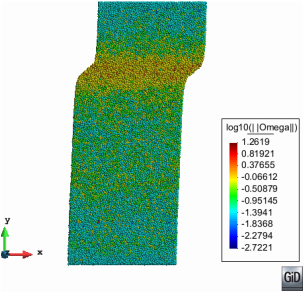 This paper presents a multi-scale lattice Boltzmann/finite element scheme that quantitatively links particulate mechanics to hydraulic properties of a grain assembly obtained from a simple shear discrete element simulation. A spatial homogenization is performed to recover the macroscopic stress from the micro-mechanical force chances. The pore geometries of the shear band and host matrix are then quantitatively evaluated through morphology analysis and flow simulations. Hydraulic properties estimated from multiscale flow simulations are compared with those inferred from volume averaging and geometric averaging schemes. Results from the discrete element simulations imply that grain sliding and rotation occur predominately within the dilatant shear band. These granular motions lead to dilation of pore space inside the shear band and increases in local permeability. While considerable anisotropy in the contact fabric is observed within the shear band, anisotropy of the permeability is, at most, modest in the assemblies composed of spherical grains. |
Group NewsNews about Computational Poromechanics lab at Columbia University. Categories
All
Archives
July 2023
|

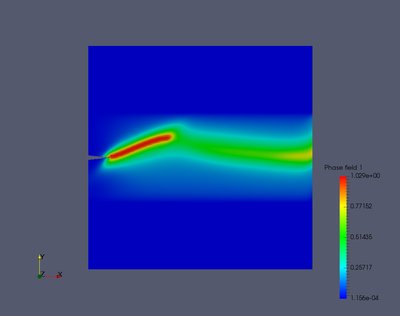
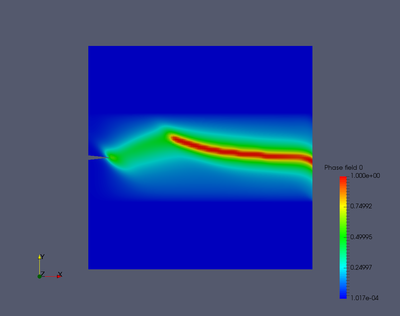
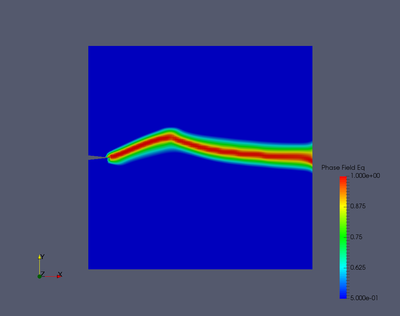
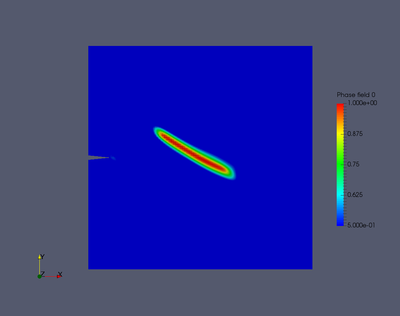
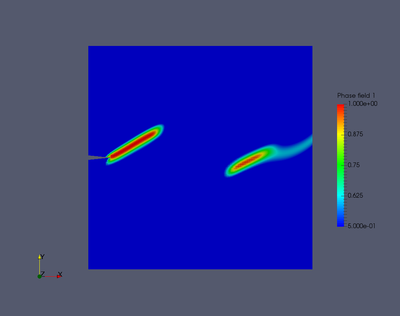
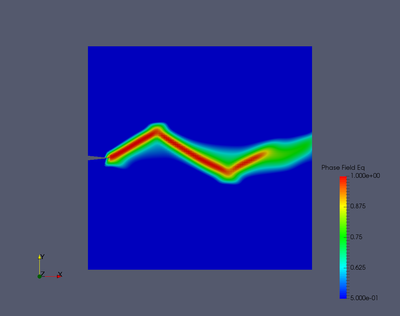
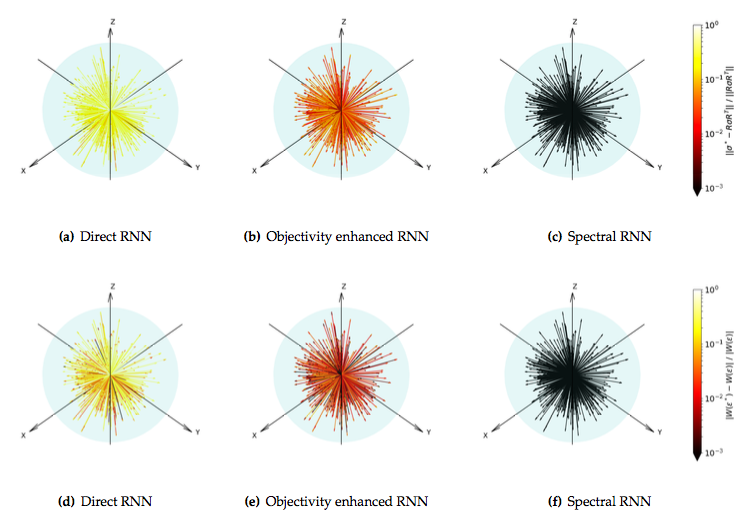
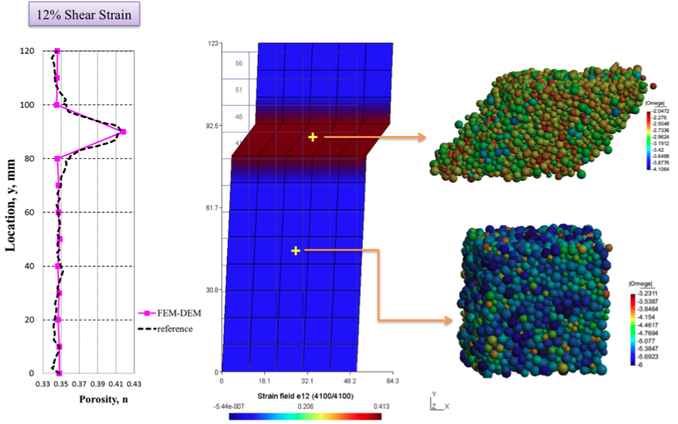
 RSS Feed
RSS Feed